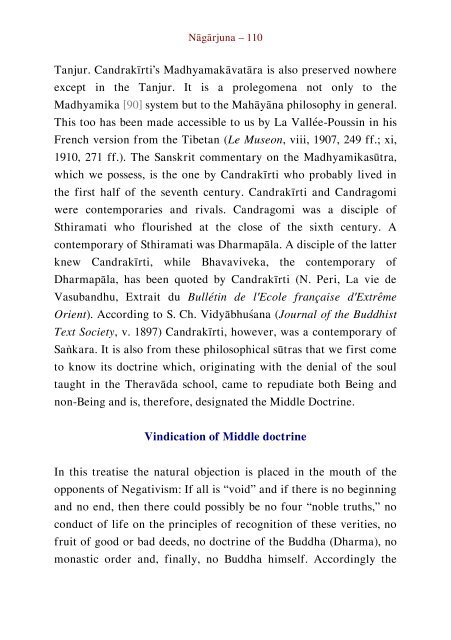Literary History of Sanskrit Buddhism
A study by J. K. Nariman of Sanskrit Buddhism from the Early Buddhist Tradition up to the Mahayana texts proper.
A study by J. K. Nariman of Sanskrit Buddhism from the Early Buddhist Tradition up to the Mahayana texts proper.
You also want an ePaper? Increase the reach of your titles
YUMPU automatically turns print PDFs into web optimized ePapers that Google loves.
Nāgārjuna – 110<br />
Tanjur. Candrakīrti’s Madhyamakāvatāra is also preserved nowhere<br />
except in the Tanjur. It is a prolegomena not only to the<br />
Madhyamika [90] system but to the Mahāyāna philosophy in general.<br />
This too has been made accessible to us by La Vallée-Poussin in his<br />
French version from the Tibetan (Le Museon, viii, 1907, 249 ff.; xi,<br />
1910, 271 ff.). The <strong>Sanskrit</strong> commentary on the Madhyamikasūtra,<br />
which we possess, is the one by Candrakīrti who probably lived in<br />
the first half <strong>of</strong> the seventh century. Candrakīrti and Candragomi<br />
were contemporaries and rivals. Candragomi was a disciple <strong>of</strong><br />
Sthiramati who flourished at the close <strong>of</strong> the sixth century. A<br />
contemporary <strong>of</strong> Sthiramati was Dharmapāla. A disciple <strong>of</strong> the latter<br />
knew Candrakīrti, while Bhavaviveka, the contemporary <strong>of</strong><br />
Dharmapāla, has been quoted by Candrakīrti (N. Peri, La vie de<br />
Vasubandhu, Extrait du Bullétin de l'Ecole française d'Extrême<br />
Orient). According to S. Ch. Vidyābhuśana (Journal <strong>of</strong> the Buddhist<br />
Text Society, v. 1897) Candrakīrti, however, was a contemporary <strong>of</strong><br />
Saṅkara. It is also from these philosophical sūtras that we first come<br />
to know its doctrine which, originating with the denial <strong>of</strong> the soul<br />
taught in the Theravāda school, came to repudiate both Being and<br />
non-Being and is, therefore, designated the Middle Doctrine.<br />
Vindication <strong>of</strong> Middle doctrine<br />
In this treatise the natural objection is placed in the mouth <strong>of</strong> the<br />
opponents <strong>of</strong> Negativism: If all is “void” and if there is no beginning<br />
and no end, then there could possibly be no four “noble truths,” no<br />
conduct <strong>of</strong> life on the principles <strong>of</strong> recognition <strong>of</strong> these verities, no<br />
fruit <strong>of</strong> good or bad deeds, no doctrine <strong>of</strong> the Buddha (Dharma), no<br />
monastic order and, finally, no Buddha himself. Accordingly the


















